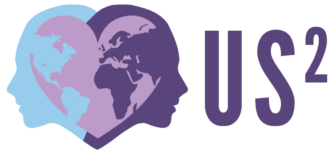In our previous blog post, we started by f understanding the key concepts of ableism. We explored the nature of ableism, uncovered its underlying assumptions and stereotypes, and delved into its institutional and cultural manifestations. Armed with this knowledge, we are better equipped to recognize and address ableism in its various forms. However, the transformational process of social justice, equity, diversity, and inclusion work doesn’t end with an understanding of societal ableism. The next challenge is perhaps the most personal and introspective one – recognizing ableism within ourselves. This task is no easy feat. It requires us to confront our own biases, assumptions, and behaviors, and it can be uncomfortable. Yet, it’s a vital step towards creating a more inclusive world.
Take a moment to reflect on what life was like before we recognized the need to address ableism within ourselves. At US², we believe that you cannot do better until you know better, so we want to encourage this exploration without shame, blame, or guilt.
Understanding the nature of implicit bias and cultivating empathy and self-awareness is the key to unraveling ableism. It involves looking within, acknowledging our biases, and actively striving for a more inclusive mindset. This blog post will guide you through this transformative process, offering insights, examples, and practical steps to help you recognize and combat ableism within yourself. Together, we’ll explore the path towards becoming more empathetic and understanding of issues surrounding social justice, equity, diversity, and inclusion.
Understanding Implicit Ableism
Implicit ableism refers to the underlying biases we hold towards individuals with disabilities. These biases can significantly impact our perceptions and interactions. In this section, we’ll break down the idea of implicit ableism. We’ll explore what it is, how it forms, and why it’s vital to recognize and address these biases.
Exploring Implicit Bias
Implicit bias is a term that might seem complex, but it’s essential to grasp its meaning in the context of ableism. Implicit bias, in simple terms, are the unconscious attitudes and beliefs we hold about individuals with disabilities. These biases are often deeply ingrained and can influence our thoughts, actions, and decisions without our conscious awareness.
Identifying Implicit Assumptions
Understanding how implicit assumptions about disabilities can affect our behavior is a critical step. We must recognize that implicit ableism often stems from unexamined assumptions we make about people with disabilities. These assumptions can be influenced by media portrayals, cultural norms, and personal experiences.
Suppose you’re watching a movie or TV show where a character uses a communication device to speak. The character’s speech might be slower or different from what you’re used to hearing. You may assume they are less intelligent or articulate due to their method of communication. This assumption, even if you don’t intend to think it, is an example of implicit ableism. It reflects preconceived notions about the capabilities of individuals with speech-related disabilities. Recognizing such assumptions is the first step towards fostering empathy and challenging these biases.
The Impact of Implicit Ableism
Consider a scenario where a job applicant discloses a hidden disability during the interview process. Without realizing it, implicit ableism might lead you to doubt their ability to perform the job effectively. As a result, they may not receive the same opportunities as other candidates. This illustrates how implicit ableism can perpetuate discrimination and limit opportunities for individuals with disabilities, and understanding the real-world consequences of these biases is essential in addressing and rectifying them.
How many of these did you recognize in yourself? In the next blog, we will discuss how you may have gotten some of those ideas, even if they are not truly how you see the world – meaning your first thoughts might not align with your core beliefs.
Cultivating Empathy in Relation to Ableism
Before we continue recognizing ableism within ourselves, let’s understand why empathy plays a pivotal role in this process. Moving toward empathy is essential when it comes to dismantling implicit ableism, and it involves active listening, learning, and taking action to promote inclusivity. In this section, we’ll explore the significance of empathy in relation to ableism. We’ll uncover what empathy means, how it can drive change, and practical steps you can take to cultivate it.
Empathy as a Tool for Change
Empathy may be a familiar term, but it’s crucial to grasp its significance in challenging ableism.
Empathy, in the context of ableism, means understanding and sharing in the feelings and experiences of individuals with disabilities. It is a powerful tool for challenging stereotypes and fostering a more inclusive society.
Imagine you meet a colleague with a visual impairment who uses a screen reader to access digital content. You notice that your team’s presentations often include complex visual graphics with no alternative descriptions. Your initial response might be indifference, assuming it doesn’t affect your colleague much. However, practicing empathy involves imagining their experience, recognizing the barriers they face, and taking action to ensure inclusivity. In this case, it might mean providing accessible descriptions for visual content, creating a more inclusive environment for your colleague.
Active Listening and Learning
To foster empathy, it’s important to learn how to actively listen and engage with the experiences of those with disabilities. Active listening involves genuinely hearing and comprehending the experiences and perspectives of individuals with disabilities. It’s a crucial step in recognizing their unique challenges and needs. We’ll also explore resources and strategies to enhance your understanding.
Taking Action and Advocacy
Empathy isn’t passive; it involves taking action. Advocacy is a powerful way to combat ableism. As you take actionable steps to promote disability inclusion in your community, workplace, and beyond, you create pathways to access and equity for everyone. Let’s say you’re part of a workplace where accommodations for employees with disabilities are lacking. You notice that a colleague with a hearing impairment often misses important information during meetings because there’s no sign language interpreter. Empathy in action involves advocating for accessible communication within your organization, ensuring that your colleague and others with disabilities have equal opportunities to participate and thrive. Your advocacy becomes a tangible expression of empathy, promoting inclusivity and fairness.
By embracing empathy as a tool for change, we can actively work towards dismantling implicit ableism within ourselves and promoting a more inclusive and compassionate world.
As we conclude our exploration of recognizing ableism within ourselves, we pause to reflect on the work we just accomplished. In this blog post, we delved into the challenging yet essential task of recognizing ableism in our own thoughts, attitudes, and behaviors, and laid the groundwork for personal growth and a more inclusive perspective. That’s not an easy task! But our transformation must continue.
The next challenge is to begin recognizing ableism in society. It’s time to turn our gaze outward and examine the systemic issues and cultural norms that perpetuate ableism. By understanding these aspects, we can collectively work towards dismantling them. Continue to “Seeing Ableism in Society,” and we’ll explore the intricate dynamics of recognizing ableism in society and learn how we can actively contribute to being the CHANGE we wish to see in the world.




